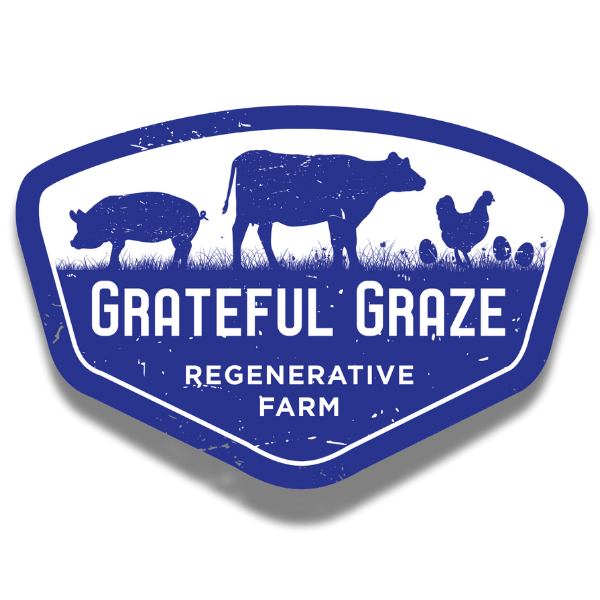CATTLE
BREED: BRITISH WHITE, ANGUS, SOUTH POLL
We love our cattle! They do amazing things for the soil and are a joy to get to work with. Our original cow group came from Gabe Brown author of Dirt to Soil and a leader of the Regenerative Ag Movement. We also have genetics from other leaders such as Christina Traeger, Gail Fuller, Mark and Annette Thomas, and Greg Judy. All are leaders in grassfed genetics.
Our cows give birth in May and June naturally, on pasture, unassisted. They nurse and protect their young and are not threatened by our presence. Our cows are required to give birth, nurse, protect, and bring their calves to 10 months of age when they are weaned without our intervention. This no excuses management practice has created a herd adapted to 100% Grassfed, no drugs, and no intervention. It is a holistic approach to what is best for the herd, the land, and us as farmers. No 3 AM calf pulling in a blizzard happens at our farm.
In addition to their excellent motherly qualities, our cattle perform exceptionally well on our pasture and cover crops, are adapted to moving frequently, and are trained to stay within their paddock with a single strand of poly wire anywhere they are. Our cattle know us, trust us, and respect us and we do the same. We never raise our voices in anger, hit, or act aggressively to our herd. If they are not doing what we would like them to do, we realize it is our fault, not theirs. Either our lack of training or something is setup incorrectly to get the behavior we are seeking. These amazing creatures are very predictable and love routine. We do everything to work with their instincts and preferences to make sure they always are living a great life.
Instead of giving our herd grains, mixed rations, antibiotics, de-wormers, hormones, insecticides, and immunizations, we give our herd fresh grazing areas called paddocks EVERY day. By keeping our cattle grouped together and moving across the landscape in a planned manner, we mimic the grazing behaviors of native ruminants such as bison, deer, elk and mammoth. Before man’s domestication of livestock, animals didn’t stay in the same place 365 days a year waiting for a meal to be fed to them and hoping someone would haul the manure away. Instead, they stayed in large groups, close together, eating-walking-defecating. They are always walking forward to get the best bite before their neighbor does and then leaving the area for a period of time allowing the grasses to regrow. Our Management Intensive Grazing practices mimic these natural movements of millions of animals with our small herd.
Bringing Livestock back to the Land(™) is THE answer for soil health, plant health, animal health and human health. Soil carbon improves substantially by taking Carbon Dioxide from the atmosphere and storing it in the soil where it helps plants thrive and the water cycle function to improve. Healthier, higher nutrient content plants protect and prosper animals. All of which creates a nutrient dense meat that you get to enjoy. Everything revolves around the soil and how we steward it. Our cattle are the key to regenerating our soil to the nutrient rich status it once had when this was a tall grass prairie and oak savannah.
It’s a difference you will taste on your plate and a difference you can see on our farm tours.
HOGS
BREED: BERKSHIRE
We select heritage breeds such as Berkshire because they are adapted to being outdoors. Hot or cold, rain or shine, our pigs simply do not get sick and are well adapted to outdoor living. Heritage breeds have higher fat content than modern confinement hogs which have been selected for leanness. This rich flavorful fat is great for you because that is where many key nutrients are stored.
Timber Raised
Our pigs are raised in timber which is a habitat that they are adapted to. We move them to new areas (paddocks) on a regular basis. They forage for nuts, leaves, grass, and literally root for roots. As they forage, they are controlling invasive species and opening up the canopy for more native grasses to grow. Our pigs have lots of room to act like pigs. We keep 100 pigs per acre which means each pig has 436 square feet compared to a small 8 square feet in a modern confinement building. We think they taste over 50 times better, too!
CHICKENS
BREED: CORNISH CROSS
At Grateful Graze, our Cornish Cross chickens are raised with care, roaming freely on lush pastures under the open sky. This hardy, fast-growing breed is known for its robust build and exceptional meat quality, offering tender, flavorful poultry that reflects our commitment to sustainable farming. Their feathers are primarily white with a soft sheen, a striking contrast to the vibrant green pastures they call home. Raised with ample space to forage and thrive, our Cornish Cross chickens embody the wholesome, natural goodness we strive to deliver from our farm to your table.
Their grass and foraging diet is supplemented with our very own homegrown Non-GMO grain to satisfy their needs. We know exactly what our livestock eat. They are quite safe and comfortable in the open air, grass floor of this building. Another layer of defense is our guard dog, Bandit. He keeps watch over the perimeter of the hoop house so the chickens can remain calm.









